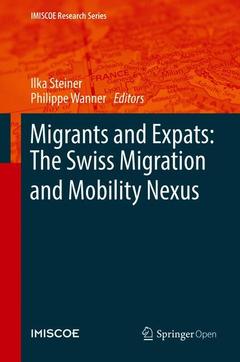Migrants and Expats: The Swiss Migration and Mobility Nexus, 1st ed. 2019 IMISCOE Research Series

This open access book provides insight on current patterns of migration in Switzerland, which fall along a continuum from long-term and permanent to more temporary and fluid. These patterns are shaped by the interplay of legal norms, economic drivers and societal factors. The various dimensions of this Migration-Mobility Nexus are investigated by means of newly collected survey data: the Migration-Mobility Survey.
The book covers different aspects of life in the host country, including the family dimension, the labour market and political participation as well as social integration. The book also takes into account the chronological dimension of migration by considering the migrants? arrival, their stay, and their expectations regarding return.
Through applying conclusions drawn from the Swiss context to the migration literature on other European and high-income countries, this book contributes to new knowledge on current migration processes in high-income countries. As such it will be a valuable reference work to scholars and students in migration, social scientists and policy makers.
Preface: Rosita Fibbi.- Acknowledgements.- Table of contents.- Contributors.- Part I. Introduction: Chapter 1 Today’s Migration-Mobility Nexus in Switzerland: Gianni D'Amato, Philippe Wanner and Ilka Steiner.- Chapter 2 Surveying Migrants in Europe. Experiences of the Swiss Migration-Mobility Survey: Ilka Steiner and Aljoscha Landös.- Part II. Migratory Process and Arrival in Switzerland: Chapter 3 Who Receives more Help? The Role of Employer Support in Migration Processes: Laure Sandoz and Fabian Santi.- Chapter 4 Who Are the Serial Movers? Sociodemographic Profiles and Reasons to Migrate to Switzerland Among Multiple International Migrants: Jonathan Zufferey.- Part III. Labour Market Participation: Chapter 5Integration of Recently Arrived Migrants in the Swiss Labour Market – Do the Reasons for Migration Matter?: Philippe Wanner.- Chapter 6 Employment Trajectories of Recent Immigrants in Switzerland: Elena Vidal-Coso.- Chapter 7 Does the Recognition of Foreign Credentials Decrease the Risk for Immigrants of Being Mismatched in Education or Skills?: Marco Pecoraro and Philippe Wanner.- Part IV. Social Life and Political Participation: Chapter 8 Immigrants’ Feelings of Attachment to Switzerland: Does the Cantonal Context Matter?: Salomon Bennour and Anita Manatschal.- Chapter 9 Who Feels Disadvantaged? Reporting Discrimination in Surveys: Daniel Auer and Didier Ruedin.- Chapter 10 Skill Levels as a Political Resource: Political Practices of Recent Migrants in Switzerland: Metka Hercog.- Part V. Transnational Life and Future Migratory Intentions: Chapter 11 How Transnational are Migrants in Switzerland? An Analysis of the Migration-Mobility- Transnationality Nexus: Eric Crettaz and Janine Dahinden.- Chapter 12 Immigrants’ Intentions – Leaning Towards Remigration or Naturalization?” Ilka Steiner.- Part VI. Conclusions : Chapter 13 Conclusions: Philippe Wanner and Ilka Steiner.
Ilka Steiner is a scientific collaborator at the Institute for Demography and Socioeconomics of the University of Geneva and part of the nccr – on the move. Also, she is a lecturer in Demography at the University of Neuchâtel in Switzerland. She is currently based the Stockholm University Demography Unit (SUDA) as a guest researcher. Her research interests lie in immigrant demography. She obtained a PhD in Demography from the University of Geneva with a focus on remigration intentions and behaviour of immigrants, under the provision of free movement of persons. In this framework, she launched a new register based longitudinal data base for migration research in Switzerland that is today used by several research teams of the nccr – on the move. Also, she coordinated the implementation of two national surveys among immigrants living in Switzerland, thereof the first wave of the Migration-Mobility Survey. Currently, she is involved in a subproject on the impact of family formation on return migration from a comparative perspective, between Switzerland and Sweden.
Philippe Wanner is professor of demography and head of the Institute of Demography and Socioeconomics at the University of Geneva. He holds a Bachelor in Economics and a PhD in Demography. He is also Deputy Director of the nccr – on the move. His research focuses on the demographic impacts of migration and on the processes of integration, as well as on the measure of migratory flows and integration dynamics. He recently edited a book on the demography of migrants (2012) and a book on the demographic trends in Switzerland (2014). He is also author and co-author of different peer-reviewed papers on migration and integration, including the integration on the labour market or migrants' health.
This open access book sheds light on how economic drivers, societal factors and legal norms shape today’s migration patterns
Provides new insights into new migration patterns and integration processes in a high-income country with high levels of immigration
Written from a pluri-disciplinary perspective it helps identify approaches and solutions which can enhance immigrants’ integration
Based on the Migration-Mobility Survey
Date de parution : 02-2019
Ouvrage de 328 p.
15.5x23.5 cm
Disponible chez l'éditeur (délai d'approvisionnement : 15 jours).
Prix indicatif 52,74 €
Ajouter au panierThèmes de Migrants and Expats: The Swiss Migration and Mobility Nexus :
Mots-clés :
Open access; Population mobility; Serial migrants; Migration and integration; Sending and receiving countries; Labor market participation; Social life and political participation; Migration-Mobility Nexus; Migration-Mobility Survey; Integration of Migrants; Migration Patterns; Surveying migrants



